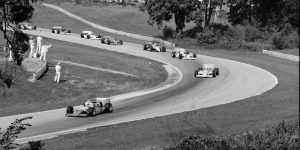What Happened On June 11th?
On June 11, 1955, what began as a day of high-speed excitement at the 24 Hours of Le Mans race ended with the loss of more than 80 lives and hundreds injured. Now, this easily became the deadliest accident in motorsport history.
Le Mans, A Hub of Racing Prestige
The 24 Hours of Le Mans, held annually since 1923, was one of the most prestigious automobile races in the world. It tested the endurance and engineering of both man and machine, with cars racing around the clock on the Circuit de la Sarthe.
The 1955 race was no different, the stadium filled with huge crowds. Interestingly, this year was the first time that the event was broadcast on television, bringing the race into homes across Europe and Asia.
Behind The Wheels
That year, the competition was fierce, with top teams from Jaguar, Mercedes-Benz, Ferrari, and Aston Martin competing for victory. Among the drivers was Pierre Levegh, a seasoned French racer driving a Mercedes-Benz 300 SLR. His car was well-known for its advanced engineering and speed. Alongside him were legends like Juan Manuel Fangio and Stirling Moss, whose skills on the track had already earned them a place in motorsport history.

The Moment Of Disaster
The race had progressed smoothly for several hours, with spectators lining the track. However, at 6:26 PM, a seemingly routine maneuver turned into a catastrophe. As the race continued, Mike Hawthorn, driving a Jaguar, moved to pit, braking abruptly. Lance Macklin, in an Austin-Healey, swerved to avoid Hawthorn and moved into the path of Levegh’s Mercedes.
Levegh had no time to react. His car clipped the Austin-Healey and was launched into the air, disintegrating upon impact with a protective barrier. The Mercedes’ debris, including the heavy engine block and hood, flew into the crowded stands at over 150 miles per hour. Spectators had no chance to escape the deadly barrage. The hood, made of lightweight magnesium, ignited upon impact, exacerbating the chaos with a massive fire.
Pits Of Despair
In the immediate aftermath, the scene was utter chaos. Fires broke out as the car’s magnesium body ignited, and emergency responders, along with brave spectators, rushed to aid the injured and extinguish the flames. Levegh died instantly, and the toll among the spectators quickly became apparent. Over 80 people perished, and many more were grievously injured. The sheer scale of the disaster overwhelmed the available medical facilities, and makeshift treatment areas were set up to manage the crisis. Notably, John Fitch, Levegh’s co-driver, later became an advocate for motorsport safety, driven by the horror he witnessed that day.
Checkered Decisions
In a highly controversial decision, the race officials allowed the race to continue. They believed that halting it would cause mass panic and further impede rescue efforts. Mercedes-Benz, out of respect for the victims, withdrew their remaining cars despite leading the race. Jaguar, however, continued, and Mike Hawthorn eventually claimed victory.

The decision to continue racing amidst the disaster remains a deeply debated aspect, highlighting the difficult choices officials had to make in crisis situations. This decision was also influenced by concerns that stopping the race would create congestion, hampering emergency services and possibly leading to more injuries.
Under The Hood
An inquiry into the disaster revealed that the design of the track and the safety standards of the cars contributed significantly to the scale of the tragedy. The narrow pit straight, where the accident occurred, left little room for error. Additionally, the design of racing cars prioritized speed and performance over spectator safety.
The magnesium body of the Mercedes, while innovative, proved lethal when it ignited, adding to the devastation. The barriers at Le Mans had not been updated since before World War II, lacking the strength needed to handle high-speed impacts. This oversight in infrastructure was a critical factor in the disaster.
Call for Change
The Le Mans disaster of 1955 had far-reaching consequences. In the immediate aftermath, motorsport events across Europe were canceled or postponed as a notion of respect and to re-evaluate safety protocols. Switzerland went a step further, imposing a ban on circuit racing that lasted until 2007.
The disaster spurred massive changes in car design, track safety, and race regulations. Barriers were strengthened, run-off areas were expanded, and the materials used in car construction were reconsidered to prevent a similar catastrophe. This incident also led to the development of the modern seat belt and the widespread adoption of crash barriers in motorsport. This showcased a major shift towards prioritizing driver and spectator safety.





